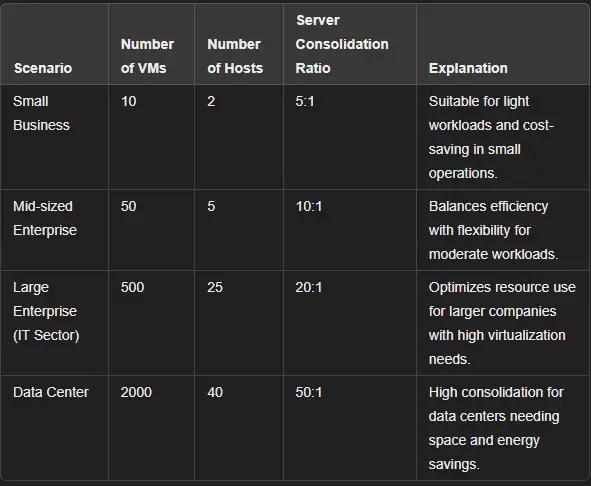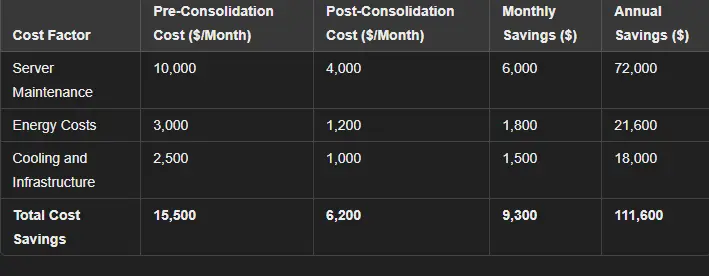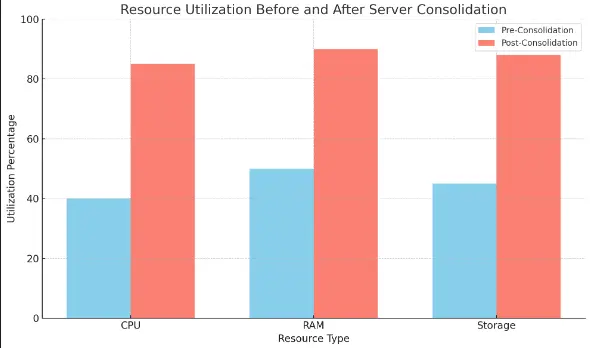With the constant development of digital infrastructure, the main issues firms face are resource management problems, energy efficiency issues, and scalability. Server consolidation is a method of streamlining IT departments to efficiently govern resources, reduce overhead costs, and create a more robust infrastructure by bringing together many servers onto fewer machines, usually through virtualization, which become high-performance computers.
Consolidation of a server environment has never been easier than now with the power tools of CyberPanel. Here we shall discuss the idea of consolidation, clarify the rationale behind consolidation ratios, and demonstrate how CyberPanel can assist organizations in their quest to modernize the infrastructure by working through the process of consolidation.
Let’s dive into the ocean of knowledge!
What is Server Consolidation?
Server consolidation, put simply, is fewer physical servers by moving most workloads onto fewer number machines. This is in some cases virtualization of making multiple virtual servers which in turn are called a Virtual Machine (VM). The virtual servers can live completely independently of one another meaning different applications or other processes can run as if they were running on a single other physical server.
Server Consolidation Key Benefits:
Reduced operational costs: consolidation reduces the demand for hardware which means that it reduces the cost of servers, energy, and cooling
Improved management of IT: If there are fewer physical boxes, it will be simple to monitor, maintain, and have fewer points of failure
Get exclusive access to all things tech-savvy, and be the first to receive
the latest updates directly in your inbox.
More efficient resource usage: Consolidation will enable the full utilization of the servers thus preventing idle resources
Environmentally friendly: Consolidation reduces the physical and energy footprint; this is in line with the sustainable practices of IT.
Server consolidation streamlines business operations, but at the same time, it allows IT teams to manage much more significant workloads and deliver superior service levels with no increased complexity.
Server Consolidation Ratios
A server consolidation ratio is one of the crucial measures for understanding how well a consolidation strategy is executed. It is the number of virtual machines with respect to physical machines. For example, for a consolidation ratio of 10:1, ten virtual servers are on one physical server.
Factors Influencing Server Consolidation Ratios
CPU: The amount of processing power that any given application will demand to function will determine the number of virtual servers a server can support.
Memory (RAM): The applications demanding the most memory would, therefore, limit how many VMs can run on a single host.
Network Bandwidth: More virtual servers require more network bandwidth. Higher workloads can demand a faster or dedicated networking solution.
Storage I/O: If most of the applications opt for I/O-intensive applications, say, like database applications, then high-speed storage will be required.
Application Compatibility: Not all applications are friendly with a virtualized environment. Therefore, compatibility testing is a must.
Increased consolidation ratios may result in more savings but will also increase the requirements for stronger hardware. Consolidation ratios should be balanced so that cost-effectiveness is achieved along with performance.

Steps to Implement Server Consolidation Successfully
1. Assess Current Infrastructure
Begin by taking a glance at the present server environment. Identify all those underutilized resources and applications running on individual servers. The server utilization and monitoring resources offered by CyberPanel will pinpoint which servers are good candidates for consolidation.
2. Select the Right Virtualization Technology
The right virtualization product, such as VMware, KVM, or Hyper-V, must be selected. These packages allow numerous VMs to run on one physical server. CyberPanel can be used with most virtualization tools; this allows easy administration.
3. Configure Optimal Server Consolidation Ratios
Determine the correct consolidation ratios using the information you gather through your evaluation. For instance, determine how many VMs each of the physical servers can genuinely support without impacting performance.
4. Create and Move Virtual Servers
Create virtual servers with CyberPanel and begin migrating applications. Migration tools in CyberPanel could make this move without any data integrity or losses, with minimal downtime.
5. Monitor and Adjust
Once the servers have been consolidated, continue tracking resource usage to adapt the consolidation ratios if necessary. With CyberPanel, you’ll get real-time tracking of resource utilization that may alert a system administrator about potential issues shortly.
Chances of Server Consolidation Problems and Their Solutions
Overloaded Physical Servers: If the consolidation ratios are higher, this will cause several performance-related issues due to the overloading of physical servers. Monitoring through CyberPanel will be very helpful in viewing the performance and adjusting the workload accordingly.
Security Vulnerability: Since the loads are centralized, these consolidated servers become highly vulnerable to security threats. Using CyberPanel’s built-in security tools like firewalls with scheduled updates will decrease the risks of security vulnerabilities.
Application Compatibility Issues: Applications aren’t all designed to be in virtualized environments. One must test applications on virtual servers before full consolidation.
Backup and Recovery: With increased chances of data loss on failure of hardware due to consolidation, recovery with the solutions provided by CyberPanel seems a much more viable promise, where the chance to lose data is even smaller.
Best Practices for Server Consolidation
Plan Consolidation Ratios: Carefully It is essential that the consolidation ratios are planned realistically and not over-loaded otherwise it won’t be very easy to run.
Prioritizing Security: The consolidated servers definitely call for robust security measures. CyberPanel offers a few excellent features through the firewall settings, and routine patch updates would keep the threats at bay.
Regular Performance Monitoring: Consolidation is a continuous process. Consolidation prevents unbalanced workloads and over/under usage of resources with regular performance monitoring.
Use CyberPanel for Effective Management: CyberPanel streamlines the management process of the server and is therefore the best tool used in maintaining consolidated environments. Use its automation, backup, and security tools for efficient server consolidation.
Mathematical Formulas for Consolidation
Server Consolidation Ratio: SCR
This ratio indicates the number of virtual servers a physical server can host.
SCR = Number of Physical Servers (Hosts) / Number of Virtual Servers (VMs)
This represents the number of virtual servers that can be supported by one physical server. The greater the SCR, the greater the resource utilization but the more the load.
Resource Utilization Efficiency : (RUE)
RUE= Actual Resource Usage / Total Available Resources *100
This is the percentage of resources utilized, enabling administrators to gain optimal capacity without overloading.
Cost Savings from Consolidation : (CSC)
CSC = (Initial Cost Servers – Post-Consolidation Cost) Initial Co
This is the percentage of savings in the cost through the consolidation of servers.
1. Server Consolidation Ratio in Real-Life Scenario
Below is the table representing the server consolidation ratio according to varied business requirements. The higher the server consolidation ratio, the better will be the utilization of available resources, but this might hamper the performance due to over-allocations of resources.

Description: This table can demonstrate consolidation ratios in real-world applications. For example, a data center may run thousands of virtual machines on a few physical hosts, thus sustaining a high consolidation ratio. In smaller businesses, though, the consolidation ratio would likely be lower so as not to overburden the system.
2. Resource Utilization Before and After Consolidation
This table provides a comparison of resource utilization metrics that reflect improvements in CPU, RAM, and storage usage after consolidation.

Description: Consolidation achieves efficient usage of resources since shared usage is made possible in the virtualized environment. Here, figures after consolidation are considerably high compared to resource usage. This translates to fewer idle resources and, consequently, reduced energy consumption, which directly implies cost savings.
3. Cost Savings through Server Consolidation
This table presents a segmentation of estimated cost savings through server consolidation based on a typical enterprise plan.

Description: This savings table on the cost will enable an understanding of how much an organization may save by implementing server consolidation. This includes just how much the company would cut off by saving and reducing operational costs every year in the issues of energy and infrastructure.
Case Studies and Practical Implementation of Server Consolidation in Real-Life
Retail industry: In retailing, the consolidation of servers helps an entity handle peak traffic seasons without buying additional physical servers. It makes scalability in the digital line of operations very cheap while offering better response times during high sales periods.
Banking Sector: Online banking, transaction processing, and data storage require financial institutions to have something more than a secure and dependable infrastructure. Consolidation of servers enables banks to save more in overhead costs while maintaining high security and availability.
Healthcare Organizations: Hospitals and clinics are consolidating the servers to offer better secure and centralized data storage for retrieval of the patient’s records while saving on the IT costs of keeping various physical servers.
IT Companies: Large IT companies with services offered on a cloud have high consolidation ratios in their data center facilities because they can support hundreds and thousands of clients. With CyberPanel tools, task management automation becomes possible while securing efficiency in the use of resources.
Resource Utilization Before And After Server Consolidation: Graph

Challenges and Solutions to Server Consolidation
More benefits from server consolidation exist, but more challenges will arise, mainly in large-scale data centers with diversified workloads. Let’s get into more detail on some of these challenges and how advanced solutions can solve them:
Balancing Consolidation Ratios with Performance
Higher consolidation ratios imply having more virtual machines crammed into a server, and if it is not monitored and managed, this might result in performance bottlenecks. For applications that are performance-sensitive or that run very intense workloads, the consolidation ratio may be set at a ratio providing added stability, for example, 3:1 or 5:1. CyberPanel resource monitoring as well as load balancing will always ensure that administrators achieve this ideal ratio, thus quick and immediate reallocation of resources when performance starts dropping.
Power Consumption Optimization with Virtualized Task Scheduling
From the above research, an algorithm for Virtualized Task Scheduling is presented that optimizes power usage by efficient workload distribution among VMs. It includes real-time monitoring of demand and resource availability to dynamically allocate tasks towards 100% utilization of servers without overloading them, thereby saving energy as well as CO₂ emissions. Optimizing every possible uptime of each server, task scheduling also reduces the downtime due to overall better usage of resources.
Reducing Environmental Impact through Green Cloud Initiatives
The traditional data center power consumption has reached its end because data centers have begun their evolution to greener operations. Green cloud initiatives, aided by virtualization and server consolidation, reduce the level of greenhouse gases. In countries facing a power deficit, energy-efficient strategies, such as server consolidation, can indeed make a difference by reducing demand on the electrical grid.
Scalability of Consolidated Servers in Highly Growing Scenarios:
This is scalable for businesses that have an emerging business, which may require rapid growth and consideration of growth into an area like e-commerce or a digital services business. With the combination of automation by CyberPanel and scheduling tasks, it is possible to add new VMs to servers without completely remodeling them, hence developing scalability into consolidation that grows with business needs.
Role of CyberPanel in Consolidation of Servers

CyberPanel is the ultimate web hosting control panel that makes server management work efficiently. With respect to consolidated environments, this control panel works very effectively. Here are some ways in which CyberPanel supports server consolidation:
Resource Monitoring: With CyberPanel, one can gain a holistic view of CPU, RAM disk usage, and many more metrics, thus optimizing server utilization by IT teams.
Automated Management: Features like scheduled backups using automation significantly reduce the amount of manual work to be managed in maintaining consolidated servers.
Security and Updates: CyberPanel offers powerful security products that help organizations protect their consolidated servers from vulnerabilities.
Database Management: CyberPanel simplifies database management, especially for high-storage applications, hence it may be possible to stream performance.
Load Balancing: Load balancing is a feature featured in CyberPanel and ensures even dispensation of workloads, thus ensuring performance across virtual servers.
Using CyberPanel’s comprehensive, robust functions ensures easy server consolidation to organizations and significant optimization of IT infrastructure for high performance and security.
Example Configuration Using CyberPanel for Server Consolidation
Here’s an example that demonstrates creating and managing a virtual server with CyberPanel:


This example shows how CyberPanel can facilitate server consolidation by allowing easy creation, management, and maintenance of multiple virtual servers.
FAQs on Server Consolidation
1. What is the optimal server consolidation ratio?
They also depend on workloads, but most people begin with ten virtual servers per one physical server. Ratios should be adapted to demands for both CPU and memory as well as to application requirements.
2. How much can I save on costs by server consolidation?
The reduction of physical machines directly reduces hardware, maintenance, and energy costs.
3. Can CyberPanel help with server consolidation?
With CyberPanel, it is easy to operate consolidated environments because it provides automated management, monitoring, backup, and security tools.
4. What is the difference between server consolidation and virtualization?
Virtualization allows several virtual servers on a single physical machine whereas, consolidation results in reducing the number of physical servers; sometimes with the help of virtualization.
5. Does server consolidation apply to all industries?
It depends on the type of workload, resource needs, and budget. Smaller businesses may consolidate fewer servers, whereas larger organizations can realize the savings.
6. Does consolidation impact application performance?
If you have the right ratio of workload to resources, then this should not affect your application performance. However, excessive consolidation on low-spec hardware can lead to a degradation in performance.
7. What are the principal risks of server consolidation?
The risks in this scenario include performance degradation, security issues, and loss of data. However, proper planning and the security features in CyberPanel mitigate these risks.
Final Thoughts: Transforming IT Efficiency Through Server Consolidation
Server consolidation is a strategic means to an end in achieving efficiency, cost-cutting measures, and optimal use of resources in the IT infrastructure of any industry. Organizations can then utilize tools like CyberPanel to guide them in streamlining their server management, enhancing security, and automating tasks to benefit the most from such a consolidated environment.
Ready to improve efficiency and save costs with server consolidation? Leverage CyberPanel’s powerful management capabilities to streamline your server infrastructure. Read more about our full suite of resources that would help you better optimize your IT strategy!



